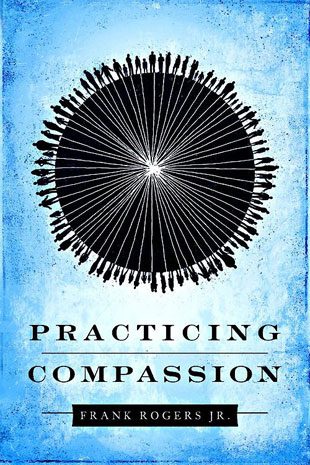
Frank Rogers Jr’s book, Practicing Compassion, is a welcome addition to the field of books bringing the positive insights and wisdom of religious traditions to a wider audience. The book sets out with the premise that while compassion is much talked about in religious settings and ever more in popular psychology, not many people know how to cultivate or practice it (although the caveat is given that there are numerous Buddhist teachings on cultivating compassion).*
Rogers is a teacher of applied compassion at Triptykos and professor of spiritual formation and narrative pedagogy and program director of the Center for Engaged Compassion at Claremont School of Theology, CA. His life of applying and teaching compassionate action shines through in every page of the book.
The book, which is inclusively interfaith in nature, follows a practical progression: explaining what compassion is and arguing that it is core of our very humanity, followed by an overview of the practice needed to cultivate compassion and then detailed chapters on the process. This process culminates in discerning practical compassionate action, as a mere attitude of compassion (happy thoughts) is acknowledged as not enough to get the job done in terms of improving one’s life and the world.
Like many “how to” books, this one runs the risk of being a dry set of instructions, jazzed up with some recent scientific evidence and the promise to make you feel better. But Practicing Compassion avoids these pitfalls. There are no appeals to science, but rather stories, some historical and others personal, that draw the reader in to the practice. And the goal is to simply become fully who we are, or at least capable of being as humans. This framework of the practice is built on a five-step process, helpfully abbreviated as PULSE:
- Paying attention
- Understanding empathetically
- Loving with connection
- Sensing the sacredness
- Embodying new life
And then ACT, taking compassionate action from this place of grounded awareness and understanding. Those who have practiced mettā-bhāvanā (cultivation of loving-kindness), will quickly feel at home here, knowing well that the process of cultivating good-will in meditation must be matched by developing better relationships in the world. Rogers acknowledges this, alongside the Ignatian daily awareness examen on page 44, saying, “These practices [the examen and mettā] recognize that the soil of our soul grows all the more fertile as these showers of kindness soak deeply within and collect into the pools of our interior reserves.”
Somewhat coincidentally, in a recent article, Reflecting on Meditation’s Ethics: Ignatian “Spiritual Exercises” and Buddhist “Mettā-Bhāvanā,” I similarly compared these two traditions, finding not only the need for meditation and one’s daily life to enter into mutually supporting dialogue, but also the importance of rich emotional language in directing and guiding the individual through the process. Rogers’ book has no shortage of that rich emotional language, repeating again and again our deep connection with compassion, whether it be through the biblical idea that our breath “flows from the very breath of God” (p.45) or the extension of compassion to “every living creature” through “the web of interconnectedness that Buddhists recognize, the circle of ancestors that indigenous traditions revere, or the face of God that Abrahamic faiths see in all aspects of creation…” (p.84). He also connects with the reader emotionally with short, touching stories, including the Rev. Dr. Martin Luther King’s powerful defense of a man who had just attacked him, the difficulty Rogers’ himself faced with staying open to a son who was habitually late and to himself when he let himself and teammates down in a softball game, and the story of bat-kid, who saved a city and opened the hearts of thousands in the process.
Reading along, one cannot help but follow the emotional journey of both the process as a whole and the stories illuminating each section. It will fit well in the “self help” section of a bookstore, though it is less flashy (no “Have everything you ever wanted in 3 easy steps!” claims) and much more substantive. In fact, early on the reader is warned, “Truth be told, however, compassion is difficult” (p.15). Indeed it is; but it’s worth it. The reader should know that and know that the work is a struggle. The book itself, in its ability to elicit one’s own struggles, becomes difficult. And that’s a good thing. With that in mind, the book might be a fit for ministers, sangha leaders, etc, and other book group leaders who want to build communities of compassion.
This kind of work is best done with friends.
* Noted are John Makransky’s Awakening through Love: Unveiling Your Deepest Goodness; Thupten Jinpa’s Compassion Cultivation Training (CCT) and Lobsang Tenzin Negi’s Cognitive-Based Compassion Training (CBCT).












